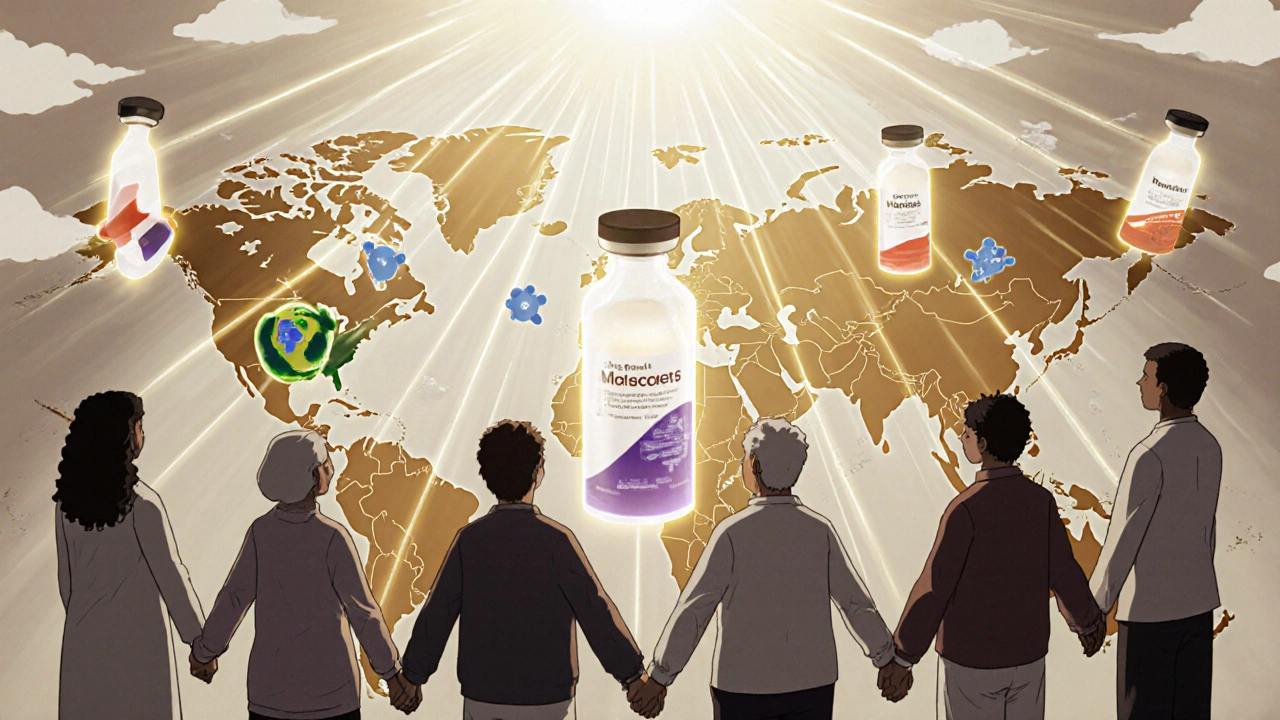Authorized Biologic Alternatives: How Biosimilars Work Like Generics
 Nov, 23 2025
Nov, 23 2025
When you need a cheaper version of a brand-name pill, you’ve probably picked up an authorized generic-same active ingredient, same results, lower price. But what if your medicine isn’t a pill at all? What if it’s an injection for rheumatoid arthritis, cancer, or Crohn’s disease? That’s where authorized biologic alternatives come in. These aren’t just cheaper copies. They’re scientifically complex, rigorously tested, and increasingly vital to making life-saving treatments affordable.
Why Biosimilars Aren’t Just ‘Generic Biologics’
People often say biosimilars are the "generics" of biologics. That’s not wrong-but it’s incomplete. A traditional generic drug, like metformin or lisinopril, is a tiny molecule made in a lab with exact chemical precision. You can replicate it perfectly. A biologic, on the other hand, is made from living cells-yeast, bacteria, or animal cells. Think of it like baking bread from scratch every time. Even with the same recipe, no two loaves are identical. That’s why you can’t make an exact copy of a biologic. You can only make a highly similar version. That’s a biosimilar. The FDA requires biosimilars to prove they match the original biologic in structure, how they work in the body, and their safety profile. This isn’t a quick approval. Manufacturers must run dozens of tests: comparing protein shapes, checking how the drug behaves in the bloodstream, measuring immune responses, and even running clinical trials to show no difference in outcomes. The bar is high. And it’s meant to be.The Difference Between Generics and Biosimilars
Here’s the real breakdown:- Generic drugs are chemically identical to their brand-name versions. They go through the ANDA pathway. Approval is based on proving bioequivalence-your body absorbs it the same way.
- Biosimilars are not identical. They’re highly similar, with no clinically meaningful differences. They go through the BPCIA pathway, which requires far more data. You can’t just test blood levels-you need to prove the whole molecule behaves the same way.
Interchangeable Biosimilars: The Closest Thing to an Authorized Generic
Not all biosimilars are created equal. There’s a special subset called interchangeable biosimilars. These are the ones that can be swapped at the pharmacy without the doctor’s permission-just like a generic pill. To get that status, a biosimilar must prove it can be switched back and forth with the original drug multiple times without increasing risk. That’s a tougher standard. In November 2023, the FDA approved the first interchangeable biosimilar for Humira (adalimumab)-Amjevita. That was a big deal. Humira is one of the most prescribed biologics in the U.S., with billions in annual sales. Now, pharmacists in states with substitution laws can switch patients to Amjevita without calling the doctor. It’s the closest thing to how generics work in the small-molecule world. But here’s the catch: only 32 states have laws that let pharmacists make that switch. In the rest, even an interchangeable biosimilar needs a doctor’s okay. That’s a major barrier to adoption.
Why Aren’t More People Using Biosimilars?
You’d think with 76 FDA-approved biosimilars and clear evidence they’re safe, usage would be high. But as of 2023, they make up less than 20% of biologic prescriptions. Why? First, confusion. Many patients and even some doctors think biosimilars are "inferior" or "experimental." That’s not true. The FDA says they’re as safe and effective as the original. A 2023 patient survey on the American Cancer Society’s forum showed someone switching from Herceptin to its biosimilar saved $750 per infusion-with zero side effects. Second, insurance plays a role. Some plans push patients to biosimilars to cut costs. But if you’re stable on your current drug, being forced to switch can feel risky-even if the science says it’s fine. A 2022 Arthritis Foundation survey found 37% of patients had disruptions when switched, though only 12% actually got worse. Third, the system is slow. Hospitals and clinics need training. Doctors need to learn how to prescribe them. Pharmacists need updated labeling systems. It takes time. One study found it takes 6-8 hours of training for rheumatologists to feel confident prescribing biosimilars.Who’s Making Them-and How Fast Are They Coming?
Big pharma is getting into the game. Amgen has 12 approved biosimilars. Sandoz and Pfizer each have 8. These companies aren’t just copying-they’re improving. Some newer biosimilars come in auto-injectors with better designs or longer shelf lives. The market is exploding. The global biosimilars market was $10.1 billion in 2022. By 2030, it’s projected to hit $58.6 billion. In the U.S., usage jumped from 5% of biologic prescriptions in 2019 to 18% in 2022. That’s fast growth. Why now? Because the patents on top-selling biologics are expiring. Humira, Enbrel, Rituxan, Avastin-all facing biosimilar competition by 2025. That’s over $115 billion in global sales up for grabs. The FDA is pushing hard. Their 2025 goal? Approving 15-20 new biosimilars a year. They’ve also updated labeling rules to make it clearer which product is which. No more confusion on the bottle.
What This Means for Patients
If you’re on a biologic, you might be offered a biosimilar soon. Here’s what to ask:- Is there a biosimilar for my drug?
- Is it interchangeable? (That means the pharmacist can switch it without calling your doctor.)
- Will my insurance cover it at the same cost as the brand?
- What happens if I switch? Will I need more monitoring?
The Bigger Picture
Biosimilars aren’t just about saving money. They’re about access. In 2023, the Biosimilars Council estimated these drugs provided over 344 million extra days of therapy that wouldn’t have happened otherwise. That’s millions of people getting treatment who couldn’t afford it before. In places like South Africa, India, and Brazil, biosimilars are already helping expand access to cancer care. In the U.S., they’re starting to do the same. The goal isn’t to replace the original. It’s to give more people a chance to live longer, healthier lives. The science is solid. The data is clear. The only thing holding biosimilars back is perception-and bureaucracy. As more doctors, pharmacists, and patients understand what they are, and how safe they are, adoption will grow. And that’s good news for everyone who needs them.Are biosimilars the same as generics?
No. Generics are exact chemical copies of small-molecule drugs. Biosimilars are highly similar-but not identical-to complex biologic drugs made from living cells. Because biologics are inherently variable, you can’t copy them perfectly. Biosimilars must prove they work the same way through extensive testing, but they’re not chemically identical.
Can pharmacists substitute biosimilars without a doctor’s approval?
Only if the biosimilar is labeled as "interchangeable" and your state allows it. As of 2023, 32 U.S. states have laws permitting pharmacists to substitute interchangeable biosimilars without contacting the prescriber. In other states, even interchangeable biosimilars require a doctor’s OK. Always check your state’s rules.
Are biosimilars safe?
Yes. The FDA requires biosimilars to meet the same high standards as the original biologic. They must show no clinically meaningful differences in safety, purity, or effectiveness. Thousands of patients have used biosimilars for years with no new safety concerns. Real-world data from cancer and autoimmune patients confirms they work just as well.
Why are biosimilars cheaper but not as cheap as generics?
Making a biosimilar is far more complex than making a generic pill. Biologics are large, delicate molecules grown in living cells. The manufacturing process is harder to replicate, requires specialized facilities, and takes longer to validate. That drives up costs. While generics can save 80-85%, biosimilars typically save 10-50%-still a major reduction, but not as dramatic.
What happens if I switch from a biologic to a biosimilar?
Most patients switch without issue. Clinical trials and real-world use show no significant difference in outcomes. But if you’ve been stable on your current drug, talk to your doctor before switching. Some patients report anxiety about change, and in rare cases, switching multiple times (e.g., brand → biosimilar → another biosimilar) has been linked to new side effects-though not proven to be caused by the biosimilar itself.
How do I know if my drug has a biosimilar?
Check the FDA’s website for the latest list of approved biosimilars. Your doctor or pharmacist can also tell you. Common biologics with biosimilars include Humira, Enbrel, Herceptin, Rituxan, and Remicade. If your drug is one of these, ask if a biosimilar option is available and covered by your insurance.
Will my insurance force me to switch to a biosimilar?
Some insurers do, especially if the biosimilar is cheaper and they’ve placed it on a preferred tier. But you have the right to appeal. If you’re doing well on your current biologic and switching could disrupt your treatment, your doctor can submit a prior authorization request to keep you on the original. Don’t assume you’ll be switched without notice.
